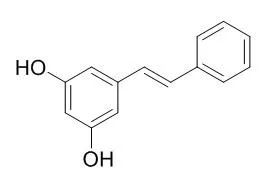| In vitro: |
| Can J Physiol Pharmacol. 2014 Dec;92(12):993-9. | | Pinosylvin at a high concentration induces AMPK-mediated autophagy for preventing necrosis in bovine aortic endothelial cells.[Pubmed: 25393712 ] | Pinosylvin is a known functional compound of the Pinus species. Pinosylvin at low concentrations (∼ pmol/L) was reported to promote cell proliferation in endothelial cells. However, this study found that Pinosylvin at a high concentration (100 μmol/L) induces cell death in bovine aortic endothelial cells. Therefore, we examined how Pinosylvin was associated with apoptosis, autophagy, and necrosis.
METHODS AND RESULTS:
Pinosylvin at a high concentration appeared to promote caspase-3 activation, nuclear condensation, and the "flip-flop" of phosphatidylserine, indicating that Pinosylvin induces apoptosis. However, based on flow cytometry data obtained from double-staining with annexin V and propidium iodide, Pinosylvin was shown to inhibit necrosis, a postapoptotic process. Pinosylvin induced LC3 conversion from LC3-I to LC3-II and p62 degradation, which are important indicators of autophagy. In addition, AMP-activated protein kinase (AMPK) appeared to be activated by Pinosylvin, and an AMPK inhibitor was markedly shown to reduce the LC3 conversion. The inhibitory effect of an AMPK inhibitor was reversed by Pinosylvin.
CONCLUSIONS:
These results suggest that Pinosylvin induces autophagy via AMPK activation. Further, necrosis was found to be promoted by an autophagy inhibitor and then restored by Pinosylvin, while the caspase-3 inhibitor had no effect on necrosis. These findings indicate that Pinosylvin-induced autophagy blocks necrotic progress in endothelial cells. | | J Nutr Biochem. 2012 Aug;23(8):946-52. | | Antimetastatic activity of pinosylvin, a natural stilbenoid, is associated with the suppression of matrix metalloproteinases.[Pubmed: 21937212 ] | Metastasis is a major cause of death in cancer patients. Our previous studies showed that Pinosylvin, a naturally occurring trans-stilbenoid mainly found in Pinus species, exhibited a potential cancer chemopreventive activity and also inhibited the growth of various human cancer cell lines via the regulation of cell cycle progression.
METHODS AND RESULTS:
In this study, we further evaluated the potential antimetastatic activity of Pinosylvin in in vitro and in vivo models. Pinosylvin suppressed the expression of matrix metalloproteinase (MMP)-2, MMP-9 and membrane type 1-MMP in cultured human fibrosarcoma HT1080 cells. We also found that Pinosylvin inhibited the migration of HT1080 cells in colony dispersion and wound healing assay systems. In in vivo spontaneous pulmonary metastasis model employing intravenously injected CT26 mouse colon cancer cells in Balb/c mice, Pinosylvin (10 mg/kg body weight, intraperitoneal administration) significantly inhibited the formation of tumor nodules and tumor weight in lung tissues. The analysis of tumor in lung tissues indicated that the antimetastatic effect of Pinosylvin coincided with the down-regulation of MMP-9 and cyclooxygenase-2 expression, and phosphorylation of ERK1/2 and Akt.
CONCLUSIONS:
These data suggest that Pinosylvin might be an effective inhibitor of tumor cell metastasis via modulation of MMPs. | | Holzforschung, 1999, 53(5):491-7. | | Efficacy of Pinosylvins against White-Rot and Brown-Rot Fungi.[Reference: WebLink] |
METHODS AND RESULTS:
Three stilbenes, Pinosylvin (PS), Pinosylvin monomethyl ether (PSM) and Pinosylvin dimethyl ether (PSD), were extracted from white spruce (Picea glauca), jack pine (Pinus banksiana), and red pine (Pinus resinosa) pine cones, and their structures were confirmed by spectroscopic and chromatographic (HPLC, GC/MS, NMR and FTIR) analysis, PS, PSM, PSD or a 1:1:1 mixture of these stilbenes at concentrations of 0.1% and 1.0% were examined for their fungal inhibitory activity by two bioassay methods. Growth of white-tot fungi (Trametes versicolor and Phanerochaete chrysosporium), and brown-rot fungi (Neolentinus lepideus, Gloeophyllum trabeum and Postia placenta) on agar media in the presence of each of the stilbenes or a 1:1:1 mixture inhibited growth of white-rot fungi, but slightly stimulated growth of brown-rot fungi. Soil-block assays. conditions more representative of those found in nature did not correlate with those from the screening on agar media.
CONCLUSIONS:
PS, PSM, PSD or a 1:1:1 mixture of the three compound\ at concentrations of 0.1 % and 1.0% did not impart any significant decay resistance to white-rot fungi inoculated on a hardwood (Red maple). However under the same conditions, decay reststance was observed against brown-rot fungi on a softwood (Southern yellow pine). It appears that stilbenes at least partially contribute to wood decay resistance against brown-rot fungi. |
|
| In vivo: |
| J Agric Food Chem. 2015 Apr 8;63(13):3445-53. | | Pinosylvin and Monomethylpinosylvin, Constituents of an Extract from the Knot of Pinus sylvestris, Reduce Inflammatory Gene Expression and Inflammatory Responses in Vivo.[Pubmed: 25763469] | Scots pine (Pinus sylvestris) is known to be rich in phenolic compounds, which may have anti-inflammatory properties.
METHODS AND RESULTS:
The present study investigated the anti-inflammatory effects of a knot extract from P. sylvestris and two stilbenes, Pinosylvin and monomethylPinosylvin, isolated from the extract. Inflammation is characterized by increased release of pro-inflammatory and regulatory mediators including nitric oxide (NO) produced by the inducible nitric oxide synthase (iNOS) pathway. The knot extract (EC50 values of 3 and 3 μg/mL) as well as two of its constituents, Pinosylvin (EC50 values of 13 and 15 μM) and monomethylPinosylvin (EC50 values of 8 and 12 μM), reduced NO production and iNOS expression in activated macrophages. They also inhibited the production of inflammatory cytokines IL-6 and MCP-1. More importantly, Pinosylvin and monomethylPinosylvin exerted a clear anti-inflammatory effect (80% inhibition at the dose of 100 mg/kg) in the standard in vivo model, carrageenan-induced paw inflammation in the mouse, with the effect being comparable to that of a known iNOS inhibitor L-NIL.
CONCLUSIONS:
The results reveal that the Scots pine stilbenes Pinosylvin and monomethylPinosylvin are potential anti-inflammatory compounds. |
|






 Cell. 2018 Jan 11;172(1-2):249-261.e12. doi: 10.1016/j.cell.2017.12.019.IF=36.216(2019)
Cell. 2018 Jan 11;172(1-2):249-261.e12. doi: 10.1016/j.cell.2017.12.019.IF=36.216(2019) Cell Metab. 2020 Mar 3;31(3):534-548.e5. doi: 10.1016/j.cmet.2020.01.002.IF=22.415(2019)
Cell Metab. 2020 Mar 3;31(3):534-548.e5. doi: 10.1016/j.cmet.2020.01.002.IF=22.415(2019) Mol Cell. 2017 Nov 16;68(4):673-685.e6. doi: 10.1016/j.molcel.2017.10.022.IF=14.548(2019)
Mol Cell. 2017 Nov 16;68(4):673-685.e6. doi: 10.1016/j.molcel.2017.10.022.IF=14.548(2019)